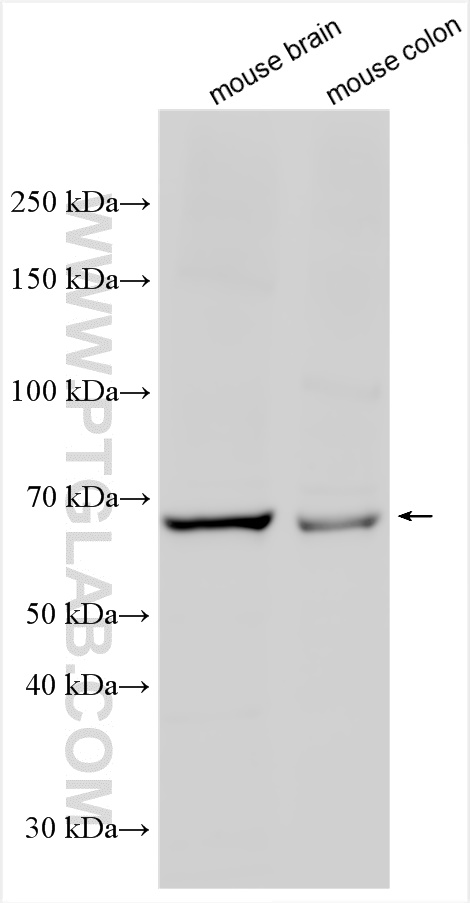验证数据展示
经过测试的应用
| Positive WB detected in | mouse brain tissue, A431 cells, mouse colon tissue, A549 cells, HEK-293 cells, HeLa cells, HepG2 cells, SH-SY5Y cells, SKOV-3 cells, Y79 cells |
推荐稀释比
| 应用 | 推荐稀释比 |
|---|---|
| Western Blot (WB) | WB : 1:500-1:2000 |
| It is recommended that this reagent should be titrated in each testing system to obtain optimal results. | |
| Sample-dependent, Check data in validation data gallery. | |
产品信息
29809-1-AP targets CAPN5 in WB, ELISA applications and shows reactivity with Human, Mouse samples.
| 经测试应用 | WB, ELISA Application Description |
| 经测试反应性 | Human, Mouse |
| 免疫原 | CAPN5 fusion protein Ag30479 种属同源性预测 |
| 宿主/亚型 | Rabbit / IgG |
| 抗体类别 | Polyclonal |
| 产品类型 | Antibody |
| 全称 | calpain 5 |
| 别名 | calpain 5, Calpain htra 3, CAPN5, FLJ46245, HTRA3, nCL 3, NCL3, New calpain 3 |
| 计算分子量 | 640 aa, 73 kDa |
| 观测分子量 | 65-73 kDa |
| GenBank蛋白编号 | BC018123 |
| 基因名称 | CAPN5 |
| Gene ID (NCBI) | 726 |
| RRID | AB_3086169 |
| 偶联类型 | Unconjugated |
| 形式 | Liquid |
| 纯化方式 | Antigen affinity purification |
| UNIPROT ID | O15484 |
| 储存缓冲液 | PBS with 0.02% sodium azide and 50% glycerol pH 7.3. |
| 储存条件 | Store at -20°C. Stable for one year after shipment. Aliquoting is unnecessary for -20oC storage. |
背景介绍
Calpain-5 is a protein that in humans is encoded by the CAPN5 gene. Calpains are calcium-dependent cysteine proteases involved in signal transduction in a variety of cellular processes. A functional calpain protein consists of an invariant small subunit and 1 of a family of large subunits. CAPN5 is one of the large subunits. Unlike some of the calpains, CAPN5 and CAPN6 lack a calmodulin-like domain IV. Because of the significant similarity to Caenorhabditis elegans sex determination gene tra-3, CAPN5 is also called HTRA3.
实验方案
| Product Specific Protocols | |
|---|---|
| WB protocol for CAPN5 antibody 29809-1-AP | Download protocol |
| Standard Protocols | |
|---|---|
| Click here to view our Standard Protocols |

